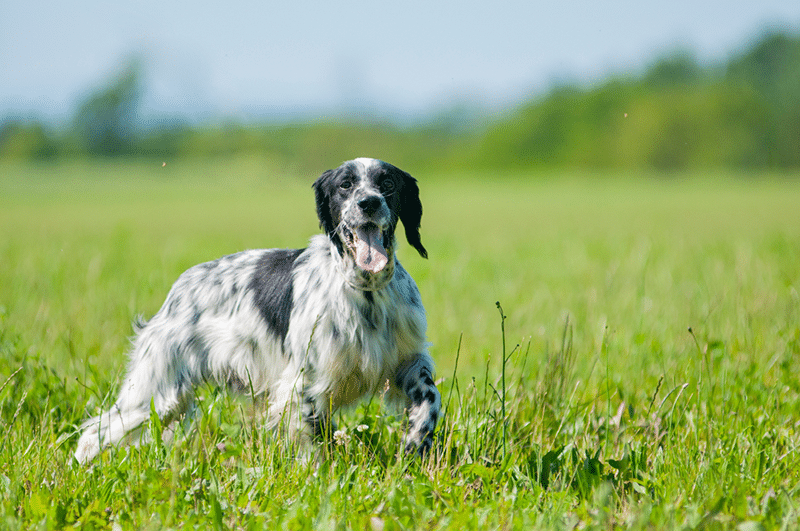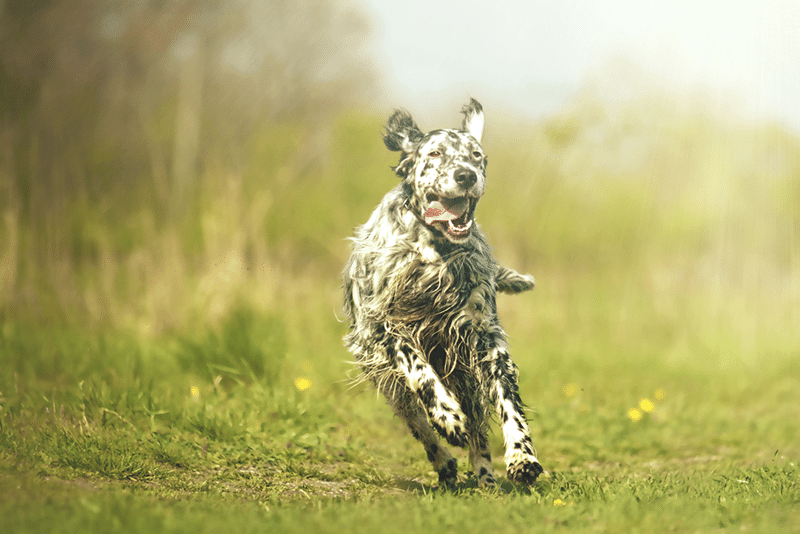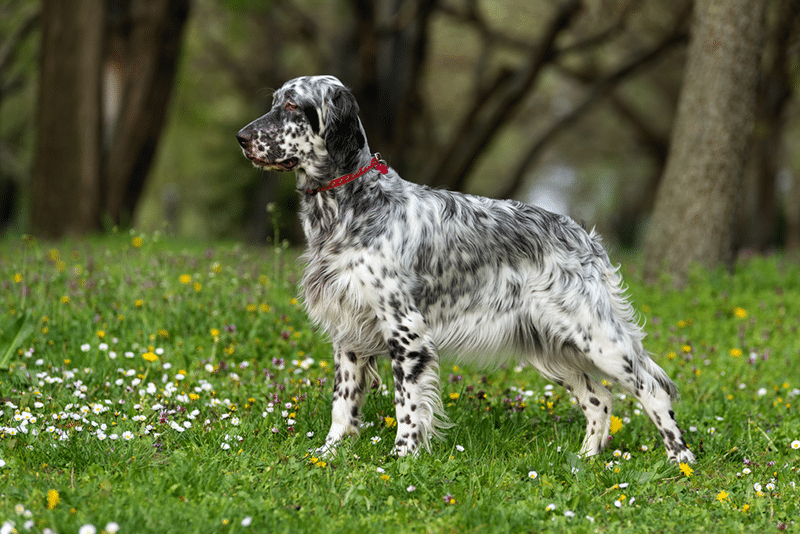In this article
View 8 More +If you’re looking for a stunning dog with an affectionate personality, look no further than the English Setter! This medium-sized dog has a long, beautiful coat and is known for being friendly, loyal, and playful. Overall, they make fantastic pets, particularly for families.
However, before adopting one, you should learn all you can about the English Setter. That’s why we’ve gathered all the relevant information you’ll need about these pups. Below, you’ll learn more about the breed’s temperament, nutritional needs, how much exercise they require, and more. Keep reading!
Breed Overview
Height:
23–27 inches
Weight:
45–80 pounds
Lifespan:
10–12 years
Colors:
White, orange belton, lemon belton, liver belton, blue belton, tri-color
Suitable for:
Active families, active singles, those with backyards
Temperament:
Friendly, energetic, playful
The English Setter is an older breed developed in the United Kingdom as a hunting dog. Country gentlemen bred them on their estates, mixing Pointer breeds with the Spaniel to make a canine that would sit (or “set”) when they found game. The English Setter’s popularity didn’t take long to grow in the UK, and they were soon exported to the United States.
English Setter Characteristics

English Setter Puppies

When you decide to get an English Setter puppy, you’ll probably have to go through a breeder. A reputable breeder will have raised your puppy with its mother and siblings and be willing to tell you the results of any health checks done on the parents. However, going through a breeder will be a bit pricey.
You might be able to locate a puppy through a rescue organization, but a rescue organization may be more likely to have older dogs rather than puppies. You can also check the local shelters, but English Setters rarely show up at them.
Although English Setter puppies can certainly be energetic, they also love cuddles.

Temperament & Intelligence of the English Setter
The English Setter is a beautiful canine, but they also are incredibly intelligent, loyal, and friendly. They are affectionate with their loved ones and always up for a quick nap or snuggle. They’re also highly energetic and need an active family to keep up with them. If the English Setter doesn’t exercise enough throughout the day, they can become bored and engage in mischievous behavior.
Because the English Setter is an intelligent sporting dog, they’re quick to pick up on commands and take great joy in learning new things. Their intelligence and desire to learn also require you to provide plenty of mental stimulation, such as outdoor games and interactive puzzles. A lack of mental stimulation can equal a bored pup!
Are These Dogs Good for Families? 👪
The English Setter is a great pet for families! However, they need to be with a family who has the time to give them the exercise they need each day and a yard they can run around in; apartment life won’t suit these pups. English Setters are great with children of any age, as they’re fairly laid back. However, due to the dog’s size and playful nature, it’s vital to monitor their interactions with young children.
English Setters can be prone to separation anxiety, too, so they’ll do better in homes where someone is there more often than not.

Does This Breed Get Along With Other Pets?🐶 😽
English Setters get along well with other animals. They’ll love playing with dogs of all sizes and can even get along with felines. However, they have hunting instincts and may “hunt” pets smaller than them. Early socialization is key to ensuring your English Setter and smaller animals get along. You should never leave your English Setter alone with smaller animals, like birds or rabbits, just in case they can’t resist their instincts.

Things to Know When Owning an English Setter
Owning a dog is a large responsibility, and you’ll need to know what to feed them, how to groom them, and what kinds of health issues they may face in the future.
Food & Diet Requirements 🦴
As with all dogs, the English Setter will need a diet of high-quality dog food that has the protein and calories required to keep up with their energy needs. However, they can be prone to obesity, and they have a tendency to overeat. Talking with your vet about how much food to give your pup is advisable. English Setters enjoy sneaking crumbs and food off countertops and have even been known to try stealing morsels left on plates, so you must keep an eye on your food and train them to leave you alone during dinnertime.
The English Setter breed can also be prone to food allergies, so watch for any signs of allergic reactions, such as itchiness or digestive trouble.

Exercise 🐕
English Setters have a lot of energy, but they don’t have as much as other sporting breeds. They need an hour or more of daily exercise to stay fit and happy. You can take your pup on long walks, let them accompany you on hikes, bring them to the dog park, or play a game of tag or fetch in the backyard.
They are quite athletic; between that athleticism and their intelligence, you’ll find the English Setter is great at sports competitions. You may want to sign them up for a training course or just set up an agility course in the backyard.
Training 🎾
Because of their intelligence and history as hunting dogs, English Setters are relatively easy to train and can pick up new commands quickly. They’re a sensitive breed, so be sure only to use positive reinforcement rather than negative reinforcement during training. Also, be aware that their prey drive and excellent sense of smell can cause them to follow their instincts, so you’ll want to begin training them early on to ensure they don’t get into trouble.
Socialization is vital for any breed, but it’s especially important with English Setters if you have a multi-pet home with small animals. Because of their hunting instincts, the English Setter may be tempted to chase after smaller pets, but early socialization can help curb these instincts.

Grooming ✂️
The English Setter has a beautiful coat, but since their hair is long, you should brush them at least twice a week, if not more. A soft-bristled brush is an excellent choice, but you might also want to invest in a metal comb with long teeth, as it can work through tangled areas. The English Setter has feathering in their coat around the ears, feet, and legs that require regular trimmings to keep it neat.
You should check your dog’s ears regularly to ensure they are clean, and baths should be given every 4–6 weeks. Their nails need monthly trimming, and their teeth should be brushed a few times a week to prevent dental issues.
Health and Conditions 🏥
The English Setter is relatively healthy but is susceptible to a few health conditions.
- Allergies
- Hypothyroidism
- Bloat
- Deafness
- Lysosomal storage disease
Male vs Female
Personality-wise, male and female English Setters are similar, but each dog is an individual and will have their own quirks. The only significant difference between the sexes is their size; males are a few pounds heavier and a couple of inches taller. Intact males and females are likelier to display undesirable behaviors, but spaying or neutering your dog can reduce their need to mark their territory or seek a mate. Because it’s more complex, spaying is more expensive than neutering.

3 Little-Known Facts About the English Setter
There’s much more to learn about this fabulous dog, so here are a few extra facts you might not have known.
1. The English Setter Is Extremely Lovely for a Reason.
English Setters are hunting dogs, but in the 19th century, people became more interested in their looks and decided to enhance their beauty via breeding.
2. The Word to Describe an English Setter’s Coloring Is Unique to them.
The word “Belton” describes the flecks of color on an English Setter’s coat.
3. The English Setter Is one of the Oldest Gun Dog Breeds.
You can find dogs resembling the English Setter in artwork from the 15th century!


Final Thoughts
The English Setter is a fantastic pet for active families and single owners. As long as you have a large, fenced-in yard for them to play in and the energy required to keep up with them, the English Setter will be one happy pup! They do well in homes with multiple pets (though you will need to watch them around smaller animals). If you don’t think you can exercise one of these dogs as needed due to lack of time or other reasons, consider another breed that looks similar but has less energy.
Featured Image Credit: zoyas2222, Shitterstock


















